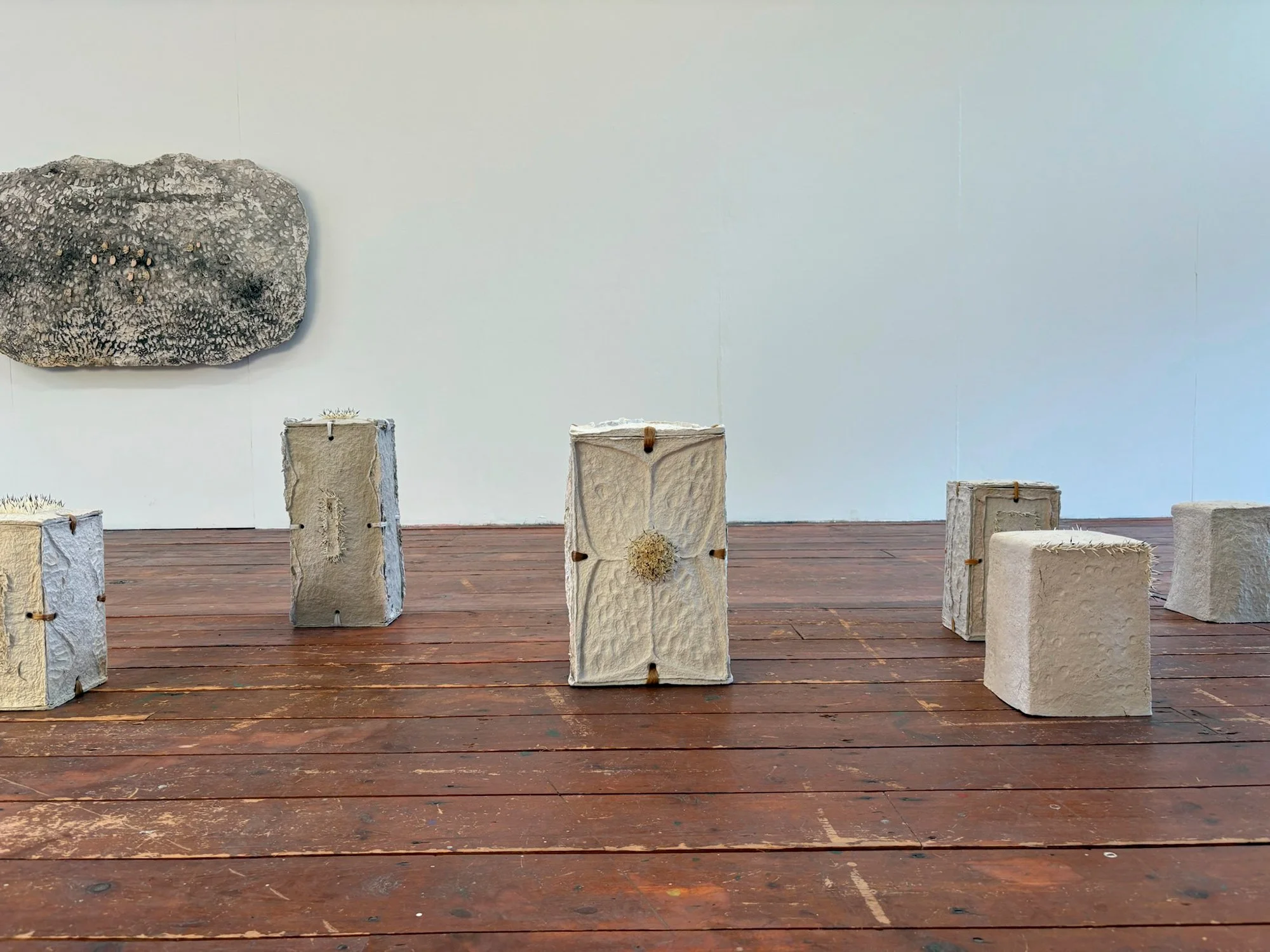Exhibition
July 18 – October 10, 2025
Al Held Foundation
Boiceville, NY
Mikayla Patton:
Holding Close
Mikayla Patton, yúzA yúzA yúzA,2025. Handmade paper, porcupine quills, india ink, wire, sweet grass, dye and fiber, dimensions variable. Background: adorning,2025. Handmade paper, porcupine quills, birch, india ink, wire, sweet grass, dye and fiber, 41 x 66.5 x 2 inches.
CLICK HERE to view the exhibition.
Dear Mikayla,
I am so delighted to be curating your first New York solo exhibition and thrilled that it will be presented by River Valley Arts Collective. It has been a great pleasure to be in dialogue with you over these past few months and I am incredibly grateful to you for sharing your thoughts, questions and process with me. Thank you for accepting my invitation to present your work at the Al Held Foundation and for allowing me to share my impressions and readings of your innovative and sensitive explorations of the visual, tactile and experiential qualities of your work.
After first meeting you last fall at the Al Held Foundation during RVAC’s felting skill-share and seeing your approach to material and process, I gained even greater understanding of your creative practice during our studio visit while you were in residence at Forge Project. It was there that I first saw your works on handmade paper, how you combine porcupine quills and glass beads with a remarkable overlay technique that involves spot-stitching those delicate materials directly onto the surface. Seeing mirrored triangles in your compositions, I recalled the Minimalist and color field provocateur Blinky Palermo whose geometric abstractions, full of triangles, hung on walls in the form of fabric, wood and metal as spatial calculations of point and line to the surface. The reference came to mind again, as I learned about the Lakota motif of doubling and mirrored designs as a way to establish a relationship between shape and the surrounding environment. After our last conversation, I drew another parallel with the articulation of spatialism and its physical expression of breaking through the surface of the canvas as a means to consider other realms and your act of transforming a flat plane into a three-dimensional object as an acknowledgement of relations between the earth’s surface and the celestial realm.
When we spoke recently in your studio at Bard, you shared how the earth has made its way into some of your sculptures by directly integrating soil into the paper pulp to create the panels of the new works. You also shared the story of coming into contact with the red earth surrounding the iconic 1200 foot monolith in northeastern Wyoming, known as the Devil’s Tower. I have since learned that it was misnamed by settlers and that a proposal by the Oglala Sioux Tribe to correct the name has been pending since 2014. You taught me that, to the Lakota, the tower is known as Mato Tipila or Mato Mountain, which can be translated to Bear’s House or Bear Lodge. The bear-themed name permeates the oral histories of the Plains and speaks to how the sacred site originated as a place of refuge from the bear who left their claw and paw marks imprinted on the earth’s surface.
This sacred story serves as a powerful reference point as I consider your new series of sculptures occupying Al Held’s former drawing studio. The seven rectangular prisms that comprise the installation, were made with clay molds that gave the handmade paper objects their open shapes, incorporating organic material such as fresh sage, sweetgrass and porcupine quills. The works’ monochromatic palette and distinct textures reveal an immense consideration for the surfaces you built up through iterative and accumulative means. The quills’ incisions and the imprints of your fingers and hands evinced on the paper surface prompts another connection to Bear’s Lodge: the monument’s prismatic column formations that score its surface. As I recall, you have referred to the sculptures as “trunks” and now, thinking about how the earth builds monuments, I can read them that way too.
We concluded the studio visit with a conversation about your process and insistence on making by way of accrued meaning rather than having an already established interpretation. We came up with a few terms such as care, enveloping and holding. I have been thinking about your large-scale wall sculptures included in this show, that are also made with clay molds marked by your hands. Particularly, I have been considering how you have held and protected these vulnerable skins with quills and by covering and securing the surfaces with india ink, ash, sweet grass, wire and dye. In that regard, I am remembering the story of the Bear Lodge and the warrior who was at the mercy of the earth whose walls rose up and were scarred as a result of that protection.
Thank you, Mikayla, for entrusting us with your work and for allowing us to provide a context for it to be seen and talked about.
With gratitude and warm wishes,
Olga
MIKAYLA PATTON (Oglala Lakota) is a multidisciplinary visual artist whose creative work intimately engages materials such as recycled handmade paper, porcupine quills, glass beads, and natural elements to create sculptural objects and installations. Through her studio practice, Patton employs Lakota methodologies and adornment practices to explore themes of healing, growth, and renewal. She has exhibited her work nationally at venues including Chiaroscuro Contemporary Art in Santa Fe, Landmark Arts in Lubbock, All My Relations Gallery in Minneapolis, and the Contemporary Arts Center in New Orleans. In 2025, her work will be featured at the Zimmerli Art Museum in New Brunswick, the North Dakota Museum of Art in Grand Forks, and the Al Held Foundation in Boiceville.
Patton holds a BFA in Studio Arts from the Institute of American Indian Arts and is currently an MFA candidate at Bard College’s Milton Avery Graduate School of the Arts.Her work is included in public collections such as the Denver Art Museum, the Tia Collection, the Atka Lakota Museum, the North Dakota Museum of Art, and The Anderson Museum of Contemporary Art. She is a 2024 Forge Project Fellow and a 2023 Joan Mitchell Fellow. Her studio practice has also been supported by the Ucross Foundation, the Native Arts and Culture Foundation, First Peoples Fund, the Harpo Foundation, the Indian Arts Research Center, the RAiR Foundation, and her community. Patton is currently based in Pennsylvania.
Organized by Olga Dekalo, Director and Curator, in partnership with the Al Held Foundation in Boiceville, NY. Over the past five years, River Valley Arts Collective has partnered with the Al Held Foundation to present exhibitions in Held’s former drawing studio, outdoor installations on the foundation's grounds and, more recently, performances in Held’s painting studio.
























